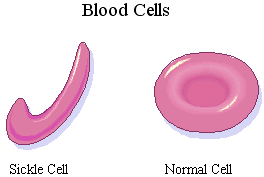Sickle Cell Disease
What is Sickle Cell Disease?
Sickle cell anaemia is a disease of red blood cells that is passed from parent to child. People with sickle cell disease have sickle haemoglobin, a protein of the red blood cells, which is different from normal haemoglobin. When a red blood cell containing sickle haemoglobin gives up its oxygen to the tissues, it changes from its usual doughnut shape to a sickle or S shape, and becomes stiff rather than soft and flexible like normal red blood cells. This "sickled cell" gets stuck in the tiny blood vessels, blocking the flow of blood and causing pain.

At the onset of the disease, red blood cells are capable of regaining their original shape and elasticity when oxygen concentration increases. However, with repeated bouts of low oxygen conditions, red blood cells permanently lose their elasticity. These rigid red blood cells are unable to flow through narrow capillaries, causing vessel occlusion and ischemia.
The spleen, an organ on the left side of the abdomen, is responsible for filtering the blood for infections and other abnormalities. Normal red blood cells can change shape and squeeze through this filter, but sickled cells get stuck and cannot recirculate through the body, so that the number of circulating blood cells goes down and body becomes anaemic. ("Anaemic" is the medical word for having a low number of red blood cells.
What are the Symptoms?
Symptoms usually begin to show in babies when they are four to six months old. Because the blood cells are sickle shaped, they sometimes get stuck in the small veins and prevent normal blood flow. These blockages cause pain in the arms, legs, back and stomach. Sometimes this pain is quite severe. Sickle cell anaemia can also cause swelling in the hands and feet, with stiff, painful joints and extreme tiredness. These painful episodes are called "crises". The problems are very variable -- some people are affected very mildly and are mainly free from pain, whilst others have more frequent and severe pains. Most children go through good and bad patches. Children with sickle cell anaemia are also more likely to develop infections and are usually recommended to take penicillin daily.
Complications
Sickle cell disease can lead to various complications, including:
- Stroke - progressive vascular narrowing (occlusion) can prevent oxygen from reaching the brain, leading to stroke; cerebral infarction occurs in children, and cerebral haemorrhage in adults.
- Anaemia - sickling due to haemoglobin S polymerisation leads to haemolysis and a decreased red blood cell count
- Cholelithiasis and cholecystitis - prolonged haemolysis may lead to excessive bilirubin production and precipitation, leading to gallstones
- Avascular necrosis (aseptic bone necrosis) of the hip
- Aplastic crisis after parvovirus B19 infection (due to arrest of erythropoiesis by the virus)
- Decreased immune reactions due to hyposplenism (malfunctioning of the spleen)
- Priaprism and infarction of the penis (in men)
- Salmonella osteomyelitis
- Opioid addiction (Often due to morphine pain relief leading to addiction)
- Acute Chest Syndrome (ACS)
Management
Reassurance, Entonox for pain relief but not for prolonged periods, oral or subcutaneous opiates are preferred if you can request paramedic backup.
ASHICE (Consider)
Transport to Hospital
Professional Handover